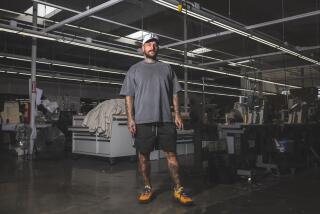Column: Soaring healthcare costs: Oh, my aching feet!

- Share via
It was one of those unexpected moments that provide a telling glimpse of why healthcare costs are so ridiculously high.
For weeks, my foot had been killing me — the ball of the foot and the tendons up top. I’d taken to hobbling around my home and the office. So I scheduled a visit to a podiatrist. I’ll call him Dr. Feet.
Dr. Feet had no difficulty diagnosing my problem as high arches, which were throwing my tendons out of whack and creating all that pain when I walked.
He said a decent pair of insoles probably would fix things.
Yeah, I could buy a pair of over-the-counter insoles for anywhere from $20 to $60. But Dr. Feet was pretty adamant that this wouldn’t be as effective as a pair of custom-made orthotic insoles, which, as it happened, his office could handle.
I asked how much that would cost.
Hundreds of dollars, Dr. Feet acknowledged, including insurance.
Ever the cheapskate, I asked which over-the-counter brands he liked.
Dr. Feet opened his drawer and took out a pad containing pictures of insoles made by a single manufacturer, Superfeet. He circled one and said some patients had reported positive results.
OK, let’s pause for a moment and look at what happened there.
After my condition was diagnosed, the doctor immediately launched into a sales pitch for a specialized medical product he could provide that can cost up to $800. The actual manufacturing cost reportedly is below $100.
It is, in other words, a major revenue generator thanks to an absurd markup (see: last week’s column on prescription eyewear).
But look what happened next. I asked about generic alternatives, and the doctor was clearly primed to recommend a specific (and costly) brand, with marketing materials within reach that presumably were provided by the manufacturer.
Which is to say, his recommendation appeared to have been influenced by a for-profit company’s sales efforts. Did money change hands? Were other perks provided? I have no idea.
But it wouldn’t be the first time a healthcare professional received special favors from the medical industry for serving as a stealth sales rep.
I’ve been stewing on this since seeing an editorial in the latest Journal of the American Medical Assn. noting that marketing by healthcare companies rose to almost $10 billion a year by 2016, compared with $2 billion in 1997.
Of that amount, at least $6 billion is being spent annually on the drug ads you see any time you turn on your TV.
“During one televised sporting event, two drug commercials ran consecutively,” the editorial noted, “one for a drug to help individuals fall sleep, followed by one for another drug to help individuals stay awake.”
We’re one of only two countries that allow direct-to-consumer drug marketing, the other being New Zealand. All other developed nations have concluded that ordinary consumers aren’t in a position to make informed decisions about prescription pharmaceutical products.
It also was reported the other day that insulin prices doubled from 2012 to 2016. The cost of living over the same period rose just 6.5%.
These soaring prices for a century-old drug are due in part to the global insulin market being controlled by just three drug companies, which get away with charging whatever they want.
The price hikes are due as well to the companies’ increasingly costly marketing campaigns, which aim to capitalize on the global diabetes epidemic as a business opportunity.
One upshot: Some people with diabetes are now rationing their high-priced insulin, which can result in serious complications and even death.
My sore foot is small potatoes by comparison.
But my experience with Dr. Feet trying to upsell me to high-priced, custom orthotics was indicative of the larger trend of putting the financial squeeze on patients, and of patient interests occasionally taking a back seat to profits.
How did that Superfeet pad end up in Dr. Feet’s exam room?
Ellen Harwick, trade marketing manager for the Ferndale, Wash., company, was surprisingly open to discussing Superfeet’s marketing efforts. She acknowledged to me that the firm reached out directly to healthcare professionals to try to influence their interactions with patients.
Harwick said, however, that most of that outreach was to general practitioners and chiropractors, not podiatrists, who she said frequently tackled issues that went beyond the power of over-the-counter insoles to solve.
Harwick said a likely scenario was that a Superfeet sales rep interacted with the pharmacy at the hospital where Dr. Feet worked, and the pharmacy in turn passed along the marketing materials to Dr. Feet and other specialists as a way to move inventory.
All I know is that Superfeet is prominently displayed in the pharmacy’s foot-care section, which I made a beeline to as soon as I left Dr. Feet’s office.
And when I asked the pharmacist which brand she recommended, she didn’t hesitate to say Superfeet. At $50, the company’s insoles were twice as expensive as others on display, and I was told I couldn’t return them once I’d tried them out.
Did they work? Not as well as hoped.
I also ordered two different pairs of arch-support insoles from Amazon. One, made by Waki Home ($19.98), did pretty well. The other, from WalkHero ($14.89), was even better.
And for puttering barefoot around the house, I can’t say enough about the JERN arch support compression band, which provides enormous relief for just $11.95.
Maybe it was just a coincidence that Dr. Feet steered me into purchasing a healthcare product that cost more than double what alternative — and, for me, more effective — products cost.
But if you look at the bigger picture, it’s hard not to believe that patients are routinely being manipulated for business purposes, and that the healthcare industry is just that. An industry.
America’s healthcare costs are the highest in the world. Yet our lifespans are shorter and our infant mortality rate is higher than in other developed countries.
Something is obviously screwed up.
It makes my foot hurt just thinking about it.
David Lazarus’ column runs Tuesdays and Fridays. He also can be seen daily on KTLA-TV Channel 5 and followed on Twitter @Davidlaz. Send your tips or feedback to [email protected].
More to Read
Inside the business of entertainment
The Wide Shot brings you news, analysis and insights on everything from streaming wars to production — and what it all means for the future.
You may occasionally receive promotional content from the Los Angeles Times.











